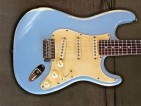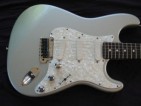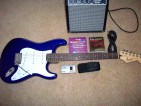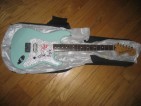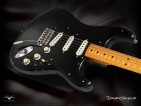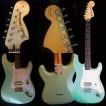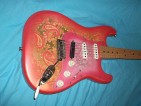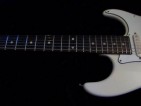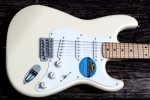Fender Stratocaster Guitars
Fender Stratocaster guitars are immediately noticeable by their distinctive shape, and can often be seen as the defining form of the electric guitar as we know it today. Simply taking one glance at the double cutaway design of the Fender Stratocaster is enough to bring images of rock n' roll concerts at the biggest of rock arenas to mind. Its reputation is well deserved, as it is the result of feedback, research and development gathered in the earliest days of the electric guitar.
The history behind this iconic instrument stems all the way back to the first prototypes that Leo Fender himself tinkered with in his workshop in the old days, and still remains a staple of many musicians today. Along with other guitars invented at the time, the Fender Stratocaster is one of the most enduring and extremely commonplace shape of guitar available today, and comes in many different configurations to meet the demands of any genre and style of music.
History of the Fender Stratocaster Guitar
The iconic design of the Fender Stratocaster guitar is a result of feedback from previous models available from Fender at the time, namely, the Esquire and Telecaster guitars. The single cutaway design of these guitars was rather uncomfortable and cumbersome to play with at times due in part to the slab-like flat body shape of the Esquire and Telecaster. The Fender Stratocaster features a contoured body design in order to make playing comfortable for longer periods of time.
Tonal variation was also made possible with the addition of a third middle pickup between the bridge and neck pickups. The electronics also received a revamp, adding in the third position for the pickup selector switch to be chosen, as well as an additional knob to further adjust levels to where the player needed to modify the most.
The modular nature of the Fender Stratocaster was also notable in this era; while most electric guitars of the time utilized set-in or neck-through designs, the Fender Stratocaster utilized a bolt-on neck design. This meant if the neck broke, then a replacement could simply be ordered and bolted on again, negating the need for the complete replacement of the guitar.
Many also consider the Fender Stratocaster guitar to be the first double cutaway design on a guitar. The double cutaway design offers easier access to the upper frets of a guitar, a godsend to more technical players who found the single cutaway on the Telecaster and other guitars at the time uncomfortable. Combined with the tonal variations possible with the added pickup, the contoured body, and the light weight of the alder construction, the Fender Stratocaster guitar was a hit the moment it came out in 1954.
The Many, Many Fender Strats Today
The Fender Stratocaster continues to enjoy widespread popularity today due to its instantly recognizable shape and tonal flexibility. Players of all genres, whether it be surf rock, ambient sound scapes, gut-busting metal, or the most artsy of art-rock bands have all found the Fender Stratocaster more than capable of keeping up with even the most intense gig because of the flexible yet time-proven design.
Fender Stratocasters today are available in a wide variety of configurations to suit any style of music. A common variation of the original Fender Stratocaster design is the pickup configuration the guitar comes in: Players wanting to keep the original Stratocaster sound but want a little more fatness in tone typically opt for a humbucking pickup in the bridge position, with the original single coil pickups still retained in the middle and neck positions. Heavier players prefer that another humbucker in the neck position, with the middle pickup omitted from the guitar entirely.
The electronics can also be varied, as players can opt for 3-way or 5-way pickup selectors as well. The latter offers a combination of 2 pickups in the 2nd and 4th position, further flexing tonal variations. Push-pull potentiometers can also be an option for the person wanting the ultimate in tone flexibility and variation.
In addition to the electronics, the Fender Stratocaster guitar also come in a wide variety of finishes, spanning from the body itself, to the pickguard, neck, fretboard, inlays, and headstock. The customizable nature of the Fender Stratocaster also contributes to why it is one of the most lasting and iconic pieces of design in our time.
Famous Fender Stratocaster Players
The sheer numbers of prominent and famous artists who have used the Fender Stratocaster guitar are mind boggling. The sound of the Stratocaster can be heard in the vast majority of genre-shaping recordings since its inception, and continues to make waves in the recording room and in the arena to this very day.
Perhaps the most prominent player of the Fender Stratocaster was Jimi Hendrix, known for his bombastic and wild playing style which was also intricate and precise. In addition to traditional guitar playing, Hendrix was also well known for his stage antics which often involved pushing the tonal possibilities of his guitar to the limit, and even destroying it outright. One notable performance was his appearance at the 1969 Woodstock festival, where his performance of “Star Spangled Banner” defied the limits of what the guitar was thought to be capable of.
Contemporary artists such as Billy Corgan and John Mayer still recognize the significance of the Stratocaster to this very day, creating music that pays homage to the Fender Stratocaster Guitar players of old while still pushing the boundaries of popular music.












